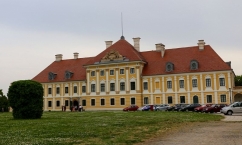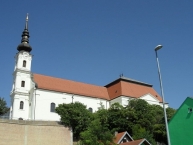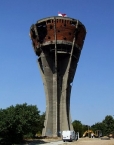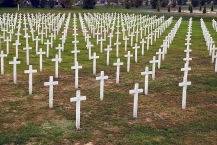Bosnien und Herzegowina Nord-Süd Radweg
Aktionen
![]()
Bitte warten - Kartendaten werden geladen
Erstellt am 03.08.2013,
am 30.11.2020
Aktionen
Strecken-Merkmale
Gesamtlänge in km
399
Informationen zu Rechten an den GPS-Track-Daten | |
|---|---|
Rechte-Inhaber | OpenStreetMap and Contributors + biroto-Redaktion (biroto.eu) |
Rechte-Ausprägung / Lizenz | Enthält Daten von OpenStreetMap, die hier unter der Open Database License(ODbL) verfügbar gemacht werden |
Link zur Rechtebeschreibung | |
gpx-Datei übernommen aus | |
gpx-Datei hochgeladen | durch biroto-Redaktion am 30.11.2020
|
Gesamtzahl Trackpoints
6.311
Trackpoint-Dichte per km
16
Endorte
Start
Vukovar, HR (93 m NHN)
Ziel
Šestanovac, HR (246 m NHN)
Fahrradfreundliche Unterkünfte, Sehenswertes und Infrastruktur
Name u. Anschrift
Breite / Länge
Tel.
Fax.
Mobile
Art d. Unterkunft
Radler-freund-lichkeit
Strecken-km
km zur Strecke
Höhe
0 km
0,9 km
82 m
1 km
0,1 km
97 m




Vukovar, The Hero Town is a city in Slavonia (eastern Croatia) along the Danube River. Although the city has a long cultural history, today it is most noted for its fate during the war in the early 1990s in the former Yugoslavia and often called "The Hero Town". It has been last and the only town in the Europe completely devastated since WWII. The Siege of Vukovar is famous among military analysts as 2,000 self-organized Croatian civilians and volunteers from all around the Croatia defended the town for 3 months against 40,000 heavy armed Serbian soldiers and 110 tanks, resulting in a pyrrhic Serbian victory. The city was defended up to the last street and therefore it was a modern model of a Stalingrad battle.
Understand
The city has long had a highly mixed population of different ethnicities, including large numbers of ethnic Croats and Serbs. As a result it suffered greatly during the war between the Croats and the Serb-dominated Yugoslav National Army in the early 1990s. The three-month siege of the city in 1991 and the subsequent occupation by Serbia destroyed or damaged much of the city's infrastructure and resulted in a massacre of Croatian population. As a result, it is difficult to find employment, and much of the population has left; around 30,000 still remain. Those who remain in the city live together nonviolently, although there is still animosity between ethnic groups. Today, it`s a living war and massacre monument.
See
The war damage is still very obvious throughout most of the city.
- ⊙Hospital: The hospital in Vukovar is the same one used during the siege of the city. Make sure to act politely and respectfully because after the "Fall of Vukovar", the Serbian army dragged all wounded people (including children) and massacred them at the "Ovčara" site, making this building a living UN critic as UN forces located outside the hospital did nothing to prevent it. The above-ground portion of the hospital has been restored into a typical modern facility, but the basement area (which was the only part of the hospital used during the siege due to the continuous shelling of the above-ground parts of the hospital) has been made into a museum. The museum is very well-designed and gives a chilling feel of what the hospital was like during the siege. While you're in the hospital, if you're lucky you may see Dr. Vesna Bosanac, who was the hospital director during the war and still works there and is regarded as something of a national hero in Croatia because she saved many lives.
+385 91 4521 222, Monday-Friday: 08h - 15h , adults – 15.00 kn - Tank Graveyard Street: A location of one of a greatest battles in Europe. In the time of a siege Serbian army, equipped with 110 tanks tried a breakthrough with tanks against a lightly armed Croatians led by national hero Blago Zadro, but it resulted in a greatest tank destruction site ever, with tanks mostly being destroyed on many unconventional ways. Today, although rebuilt it still gives an unexplaineable chilling feel of a battle, and one tank is left as a memorial.
- ⊙Municipal Museum: The museum in Vukovar placed in the baroque Eltz castle, is horribly damaged from the war, but it is still in use, and there are plans to reconstruct the museum in 2009. Aside from the war damage, the museum has various exhibits to see. Many of the pieces are archaeological artifacts, including a right-footed ceramic shoe from several thousand years ago (Vučedol culture) that the museum staff seem to be particularly proud of. The museum also periodically exhibits paintings from the Bauer collection which is considered one of the more significant collections of Croatian modern art.
- ⊙Ovčara massacre site: The Ovčara field is a short drive from the main area of Vukovar. After the fall of the city to the Serb-dominated Yugoslav National Army, the Serb soldiers gathered 200 of the hospital's doctors and injured patients and massacred them in the Ovčara field. Today at the massacre site there is a memorial and a nearby museum.
☎ +385 32 512345, every day: 10h - 17h - ⊙Memorial Cemetery: The cemetery has the graves of many who died during and after the siege. At the center of the cemetery is a memorial statue. The statue has a symbolic flame at its center, and the stones present the image of the Christian cross facing outward in all directions. While walking among the graves, there are several interesting things to consider: Graves labeled 'Hravtski Branitelj' are the graves of untrained volunteers who helped defend the city. People who died after November 18 were usually tortured to death. There are also many graves where you can see that an entire family died on the same day.
☎ +385 32 412980, every day: 8h - 20h
WARNING: There are active mines in the woods around the Vukovar cemetery. Only walk through the cemetery's paved and grassy areas. Avoid the woods. - ⊙Crkva Sv. Filipa i Jakova: This is the main Catholic cathedral in the city. It is the 3rd longest church in Croatia and also has the 3rd most significant library in Croatia with several books (incanabulae) from the 15th century. It was horribly damaged during the war. There have been slight reconstructions since the war (Namely, a simple roof was added in order to keep out the rain. The church also has a new organ.), although the cathedral is generally the same as it was in 1998. The walls of the church still bear many holes from mortar shells and grenades, and there is still graffiti that was left by the Serb soldiers, including images of Orthodox Christian crosses and a slogan that translates into English as "God forgives. Serbs don't." If you have extra time and money, you may want to hire a Croatian translator and arrange a visit with the priest, as he is extremely knowledgeable about Vukovar, the siege, and what occurred at the cathedral during the siege. As it is placed on a hill over the Vukovar centre it has a great lookout over the city and the Danube river.
Do
Walk the streets. It's as moving as visiting any war museum!
Informationen zu Urheber-Rechten | |
|---|---|
Rechte-Ausprägung / Lizenz | by-sa: CREATIVE COMMONS Namensnennung, Weitergabe unter gleichen Bedingungen |
Link zur Rechtebeschreibung | |
Text(e) übernommen von: |
Wikivoyage contributors, 'Vukovar', Wikivoyage, The FREE worldwide travel guide that anyone can edit, 18 March 2016, 12:48 UTC, <https://en.wikivoyage.org/w/index.php?title=Vukovar&oldid=2959789> [accessed 30 August 2016] |
übernommen / bearbeitet am | 30.08.2016
|
übernommen / bearbeitet durch |
|
